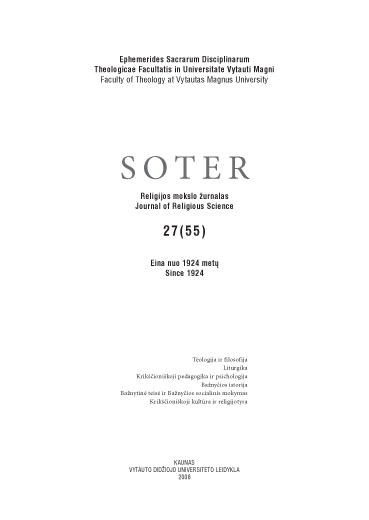Liturgijos atnaujinimas ir muzika: popmuzika katalikų bažnyčiose – liturginės reformos vaisius?
Liturgical Renewal and Music: Pop Music in Catholic Churches - the Fruit of the Liturgical Reform?
Author(s): Danutė KalavinskaitėSubject(s): Christian Theology and Religion
Published by: Vytauto Didžiojo Universitetas
Keywords: bažnytinė muzika; roko ir popmuzika; liaudiškos Mišios; Vatikano II Susirinkimas; liturginis atsinaujinimas (reforma); įkultūrinimas; veiklus dalyvavimas; muzikos terapija; church music; rock and pop music; hootenanny Mass; the Second Vatican Council,...
Summary/Abstract: The Second Vatican Ecumenical Council officially initiated the liturgical renewal by allowing the use of national languages in all rituals and thus encouraging believers for more active participation. Both the Ecumenical Council itself and all later guidelines of the Catholic Church concerning the liturgical reform represent a response to the seeking of 20th century Catholics to return to the origins of Christianity and to new challenges raised by society’s development. Implementation of the reform rippled through Catholics (the intelligentsia first of all) not only as the liturgical renewal, but also as an overturn and decline of confessional culture, when old values are being destroyed and new ones are not being created. This fall was also influenced by the social situation of that time – a kind of a new Iconoclastic era and the cult of youth in Western countries that prospered after World War II - which determined that everything that was not contemporary in church art and required efforts to learn (chorals, classical polyphony, professional music making) was considered by many people as phenomena of the elite and of church authoritarianism that should be supplanted. Regardless of the formation of Liturgical and Church Music Commissions in each region for the proper implementation of the Council’s Constitution “Sacrosanctum Concilium” (1963), the rapid spread of “folk” and the so-called “youth” Mass began both in the United States and Europe as early as 1965-66; it was the start of a period of simple musical language, “self-made” church music, which required no high proficiency. The last two decades since the apostolic letter of Pope John Paul II (“vicesimus quintus annus”, 1988) have been marked by increased longing for liturgical magnificence, mysteriousness and adoration practices. Among phenomena symptomatic for this period the first to be mentioned are formation of international organizations (in the last decade of the 20th century) that seek to unfold again the beauty and sanctity of the Church tradition and the holy See’s rescript (motu proprio “Summorum pontifcum” of Pope Benedict XVI, 2007) on the celebration of the Tridentine Mass in Latin along with the already usual reformed liturgies. To summarize briefly more than four decades of the liturgical renewal, we can say that the implementation of the reform was constantly exposed to the tension between two extreme “camps”: protectors of the traditional high-level Church culture who protected the value of liturgical art as a norm of liturgy and pastoral care, and liturgists and pastoral ministers (German seelsorger), who sought to instill “living belief” in each Church member. Church pop music originated as an expression of the second “camp’s” ideology, enthusiasm of the believers (particularly young believers) and their eagerness to create a new liturgical tradition. New spiritual untraditional chants are reprehended for primitive, egocentric texts and music, excessive emotionality
Journal: SOTER: religijos mokslo žurnalas
- Issue Year: 55/2008
- Issue No: 27
- Page Range: 113-126
- Page Count: 14
- Language: Lithuanian

